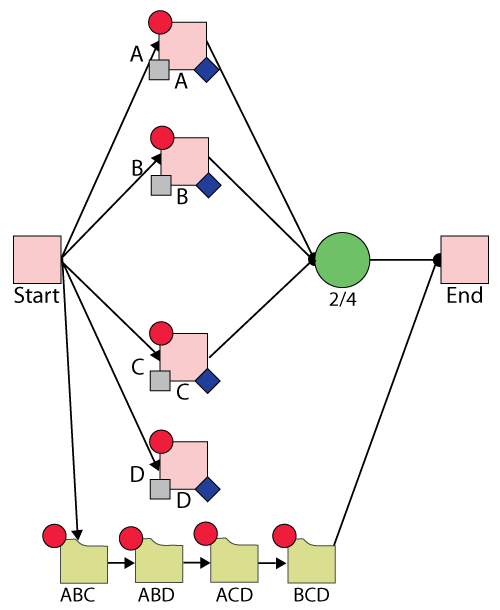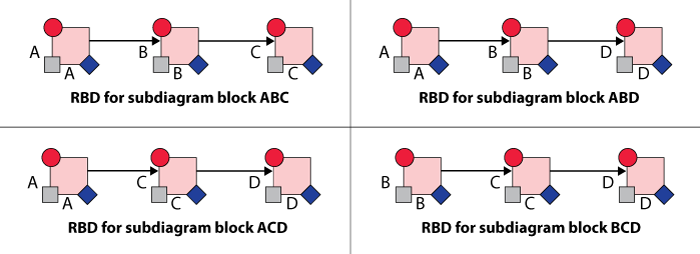Template:System with Two Standby Blocks (SCT solution)
Two Standby Blocks
Purpose
The purpose of this example is to illustrate how to model a system with two standby devices with SCT.
Statement
Assume that there are four devices A, B, C and D in the system. The system begins with A and B as active devices and C and D as standby devices. At least 2-out-of-4 devices have to be in active status to assure that the system is working. If one of the active device fails, one of standby device will be activated. After the active device is restored, it would become a standby device. For example, when A fails, C or D would be activated and become a active device. After A finishes repair, it would become a standby device.
BlockSim Solution
It is easy to model this system with standby container. However, standby container has some limitations in other application. Here we want to model this system with SCT. It is not possible to model this system directly with SCT. Here we present a alternative solution which can approximate this system.
The logic is like this: We will activate all standby devices whenever a active device fails. After activating all standby devices, we will check how many devices are in active status. If there are more than 2 devices in active status, we will deactivate some of them to assure that there are exactly two devices in active status at every moment. The drawback of this solution is that it would activate and deactivate the devices multiple times than we expected. For example, if A and B are active and when A fails, it would active C and D. After activating C and D it would detects that there are three devices are in active status, then it would deactivate one of the three active devices: B, C and D. As we can see, it has the chance to deactivate B instead of C and D,which is not that we expected. If there is extra cost or delay time related to activation, this solution is not a good option.
In order to detect that there are more than two devices are in active status, we have four subdiagram blocks: ABC, ABD, ACD and BCD. ABC contains mirror blocks A, B and C in series. The RBDs for main diagram and subdiagram are as followings.
Mirror group A includes Block A in main diagram, Block A in subdiagram ABC, Block A in subdiagram ABD and Block A in subdiagram ACD.
Mirror group B includes Block B in main diagram, Block B in subdiagram ABC, Block B in subdiagram ABD and Block B in subdiagram BCD.
Mirror group C includes Block C in main diagram, Block C in subdiagram ABC, Block C in subdiagram BCD and Block C in subdiagram ACD.
Mirror group A includes Block D in main diagram, Block D in subdiagram ABD, Block D in subdiagram ACD and Block D in subdiagram BCD.
All four blocks (A, B, C and D) follows W(1.5,100) for reliability and have CM with duration = 100 hours.
Block A is belong to maintenance group A. It has SCT with initial state ON and state upon repair Default OFF unless SCT overridden. If any item from maintenance group B, C and D goes down, Block A is activated. If any item from maintenance group ABC is restored, Block A is deactivated.
Block B is belong to maintenance group B. It has SCT with initial state ON and state upon repair Default OFF unless SCT overridden. If any item from maintenance group A, C and D goes down, Block B is activated. If any item from maintenance group ABD is restored, Block B is deactivated.
Block C is belong to maintenance group C. It has SCT with initial state OFF and state upon repair Default OFF unless SCT overridden. If any item from maintenance group A, B and D goes down, Block C is activated. If any item from maintenance group ACD is restored, Block C is deactivated.
Block D is belong to maintenance group D. It has SCT with initial state OFF and state upon repair Default OFF unless SCT overridden. If any item from maintenance group A, B and C goes down, Block D is activated. If any item from maintenance group BCD is restored, Block D is deactivated.
Subdiagram block ABC is belong to maintenance group ABC. Other three subdiagram blocks are also belong to the maintenance groups with the same name.


System Events
The system event log (simulation seed: 9) is shown Block Up/Down plot below, for a single run through the simulation algorithm and is as follows:
- At 26, Block A fails. Block C and D are activated. However, there are three blocks in active status, thus Block D is deactived immediately.
- At 126, Block A finished its repair. According to settings, Block A is OFF as standby device.
- At 224, Block C fails. Block A and D is activated. However, there are three blocks (A, B, and D) in active status, thus Block B is deactivated immediately. NOTICE: B should not be deactived here, however we cannot control. This is the drawback of this solution. If there is extra cost or delay time related to activation and deactivation, we are waste of resource by deactiving Block B.